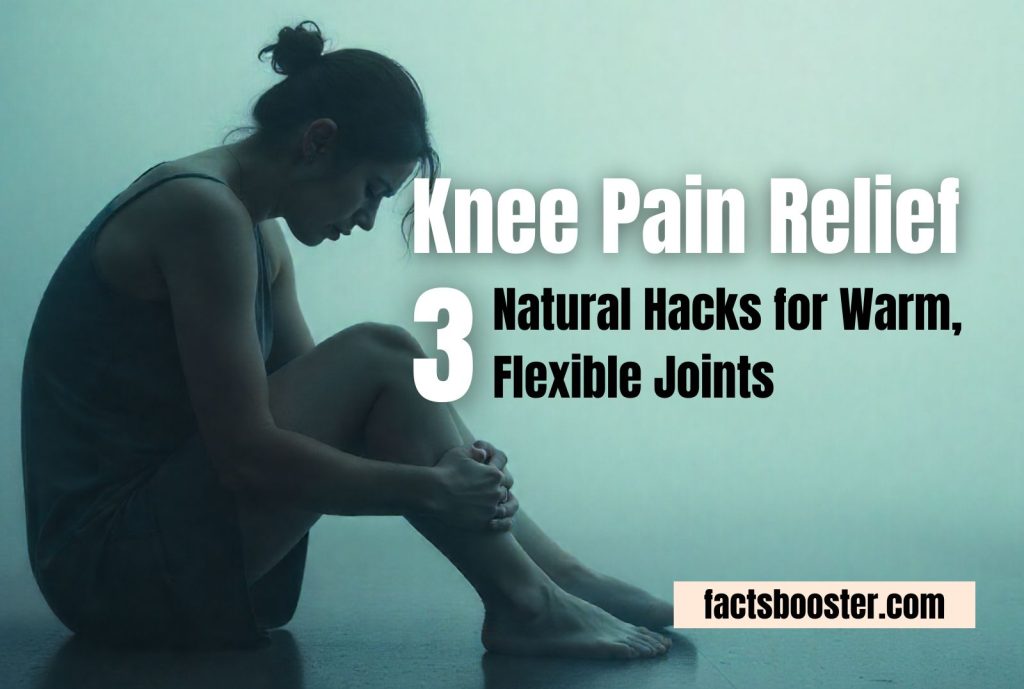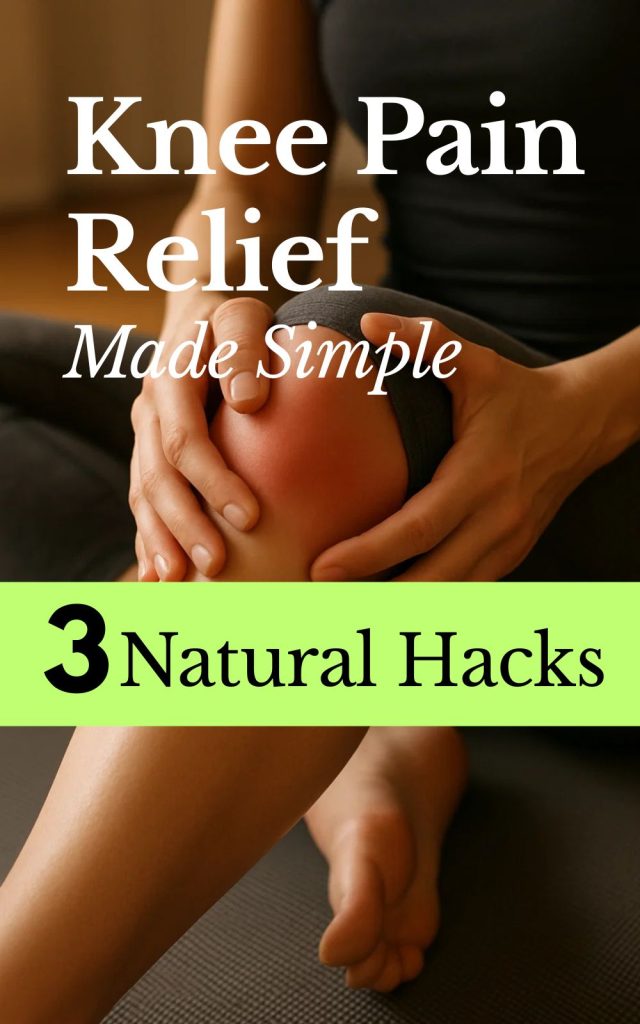Knee pain relief is what everyone hopes for when their knees ache—especially during cold or rainy weather. Anyone who’s dealt with achy knees knows how frustrating it can be. Your knees feel stiff, sore, and icy cold, even through thick pants. It’s like the chill has settled deep into your bones.
The temptation to pop painkillers or even consider surgery is real. But here’s the thing: if you don’t address what’s actually causing the pain, true knee pain relief will be hard to achieve, and the discomfort will just keep coming back—maybe even spreading to other joints.
Most of the time, stubborn knee pain comes down to two things: cold and dampness getting into your joints, and poor blood flow. When your circulation slows down, cold-dampness sneaks in, making your joints stiff and eventually wearing down the cartilage. Over time, bone spurs can develop. Just gritting your teeth through the pain or masking it with medication won’t fix the real problem.
The good news? You don’t need expensive treatments. There are three simple things you can do at home to kick out that cold-dampness and get real knee pain relief: warming soups, ginger-and-scallion compresses, and daily acupressure. Stick with these, and you’ll notice your knees warming up, feeling less stiff, and moving better.

Why Your Knees Hurt in the First Place
Cold weather and dampness love to settle into your joints. When your circulation isn’t great and your energy (or “qi”) is blocked, your knees don’t get the nutrients they need. That leads to stiffness and soreness. Everyday things like drinking iced coffee, getting caught in the rain, or pushing yourself too hard can make cold-dampness worse. Fixing these habits is step one in keeping your knees warm and healthy.
How Cold and Dampness Creep Into Your Knees
Ever notice your knees feel especially stiff on cold, windy, or rainy days? That’s cold-dampness working its way in. When your body’s energy is low and your circulation is sluggish, cold finds a way into your joints. Poor blood flow means the cartilage and tissues around your knees aren’t getting fed properly, which gradually causes stiffness, pain, and breakdown.
When Blood Flow Gets Blocked, Pain Follows
There’s an old saying: “If it doesn’t flow, it hurts.” That’s exactly what happens with your knees. When circulation slows and your metabolism drags, waste builds up in the joint fluid instead of getting flushed out. Over time, this can lead to bone spurs. Knee pain relief isn’t just about comfort—it affects everything from walking and climbing stairs to getting a good night’s sleep. Painkillers alone won’t unblock that flow, so the pain keeps returning.
Daily Habits That Make Things Worse
Cold-dampness doesn’t just come from the weather. Your daily routine plays a big role too. Eating cold foods—ice cream, smoothies, raw salads, or fruits like watermelon and pears—or getting soaked in the rain, or burning yourself out at work can all invite cold-dampness into your knees. The more this happens, the more frequent and stubborn the pain becomes. Changing these habits is your first line of defense.
How to Get Knee Pain Relief at Home: Drive Out Cold-Dampness and Protect Your Joints
Once you understand what’s really going on, treating knee pain gets a lot simpler. Improving circulation and reducing cold-dampness can seriously ease that soreness and stiffness. Here are three easy home methods you can start using today for effective knee pain relief:
1. Warming Soups
Ingredients: Lamb, Angelica (Dang Gui), Ginger
How Often: 2–3 times a week
What It Does: Warms your body, drives out cold, gets your blood moving
You don’t need fancy supplements—just a good, warming soup. Lamb builds up your body’s heat, helping you fight off cold-dampness. Angelica (Dang Gui) gets your blood flowing, gradually pushing that cold out of your joints. Ginger warms you from the inside, helping your knees “thaw out” and easing stiffness.
Sipping a hot bowl of this soup feels like warmth spreading through your knees. The stiffness melts away, replaced by a comforting heat. It’s not just food—it’s knee pain relief that helps your joints feel alive again and keeps that cold-dampness from settling back in.
2. External Ginger-Scallion Compress
Ingredients: Ginger + Scallion (the white part)
How to Use: Crush them together, wrap in gauze, and apply to the sore spots on your knees
What It Does: Sends warmth deep into the joint, eases pain
Compresses are one of the most direct ways to tackle knee discomfort. The warmth from ginger and scallion gets your blood moving and helps push cold-dampness out. Use it daily, and your knees will feel “woken up” by the heat—less stiff, less sore. If cold-dampness has really settled deep into your bones, this method works wonders for knee pain relief.
3. Acupressure Massage
Key Points: He Ding, Inner Knee Eye, Outer Knee Eye
How Often: 5 minutes, morning and evening
How to Do It: Press gently until you feel a slight tingling or fullness
Acupressure is simple but powerful for knee pain relief. Massaging these key spots around your knee helps blood and energy flow, warming the joint and pushing out cold-dampness. Do it regularly, and you’ll notice less pain, healthier joints, and better flexibility. It also helps prevent long-term joint breakdown, so your knees stay strong and less likely to flare up again.
Boost your energy and feel amazing — start your 7-Day Energy Reset today!
Daily Knee Care Tips for Lasting Relief
Getting knee pain relief isn’t just about soups, compresses, or massage—you need to take care of your knees every day. If you ignore your habits and don’t keep your knees warm, cold-dampness will just come back, and so will the pain. Here are some small steps that make a big difference:
Don’t Overdo It
Sweating too much drains your body’s energy, leaving your knees vulnerable to cold. Pace yourself and take breaks when you need them.
Skip the Cold Stuff
Cold drinks, raw foods, and chilly fruits can make cold-dampness worse. Stick to warm, easy-to-digest foods to keep your knees comfortable.
Keep Your Knees Covered
On cold or rainy days, protect your knees with long pants, knee braces, or heat packs. This keeps cold-dampness from creeping back in and prevents pain from returning.
Final Thoughts
Persistent knee pain usually isn’t just a random injury. It’s often cold-dampness settling into your bones combined with poor circulation, leading to stiff joints, worn-down cartilage, and eventually bone spurs.
But here’s the good news: warming soups, ginger-scallion compresses, and acupressure massage can help drive out that cold-dampness, reduce soreness, and get your joints healthy again. The secret is consistency, along with smart daily habits—avoiding overwork, staying warm, and eating the right foods. With time and care, your knees can feel warm, flexible, and strong again. That’s real, lasting knee pain relief.

References:


